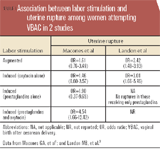VBAC attempt: Induction and augmentation of labor
A woman had a cesarean delivery through a lower-segment transverse incision in her first pregnancy because of arrest of descent. She has had a uncomplicated second pregnancy and desires a trial of labor; however, at 39 weeks, she requests labor induction because of her husband's travel schedule. Learn how labor induction can affect the risk associated with vaginal birth after cesarean delivery.
Q. A 32-year-old woman (gravida 2 ,para 1) had a cesarean delivery through a lower-segment transverse incision in her first pregnancy because of arrest of descent. She has had an uncomplicated pregnancy and desires a trial of labor; however, at 39 weeks, she requests labor induction because of her husband's travel schedule. How does labor induction affect the risk associated with vaginal birth after cesarean delivery? What guidance would you give this patient?

Taken together, these studies suggest that there may be a small increase in the risk of uterine rupture associated with labor augmentation or induction in women with a prior cesarean, the highest risk is in those patients who require the combination of prostaglandins and oxytocin.3 Therefore, caution should be used during induction of women with an unfavorable cervix and a prior cesarean delivery.
If delivery is required for a medical indication (eg, preeclampsia), what would be the optimal approach?
Certain conditions, such as preeclampsia or fetal growth restriction, will require early delivery in spite of a prior cesarean delivery. The approach in this situation will depend on the patient's cervical exam. If the cervix is favorable, proceeding with induction using oxytocin alone is reasonable.
The situation is more complicated if the cervix is unfavorable. Data suggest that induction with an unfavorable cervix that requires the use of multiple agents is associated with a higher risk of uterine rupture.1 If the cervix is unfavorable, repeat cesarean delivery is reasonable. If labor induction is undertaken, it should be done with caution.
Patients who may be an exception to this management approach are those women who have had a prior vaginal delivery (either a prior successful VBAC or a prior vaginal delivery that predated their cesarean delivery). These patients have a lower risk of rupture, even if labor induction is required,4 and they are potentially better candidates for labor induction in the setting of an unfavorable cervix.
